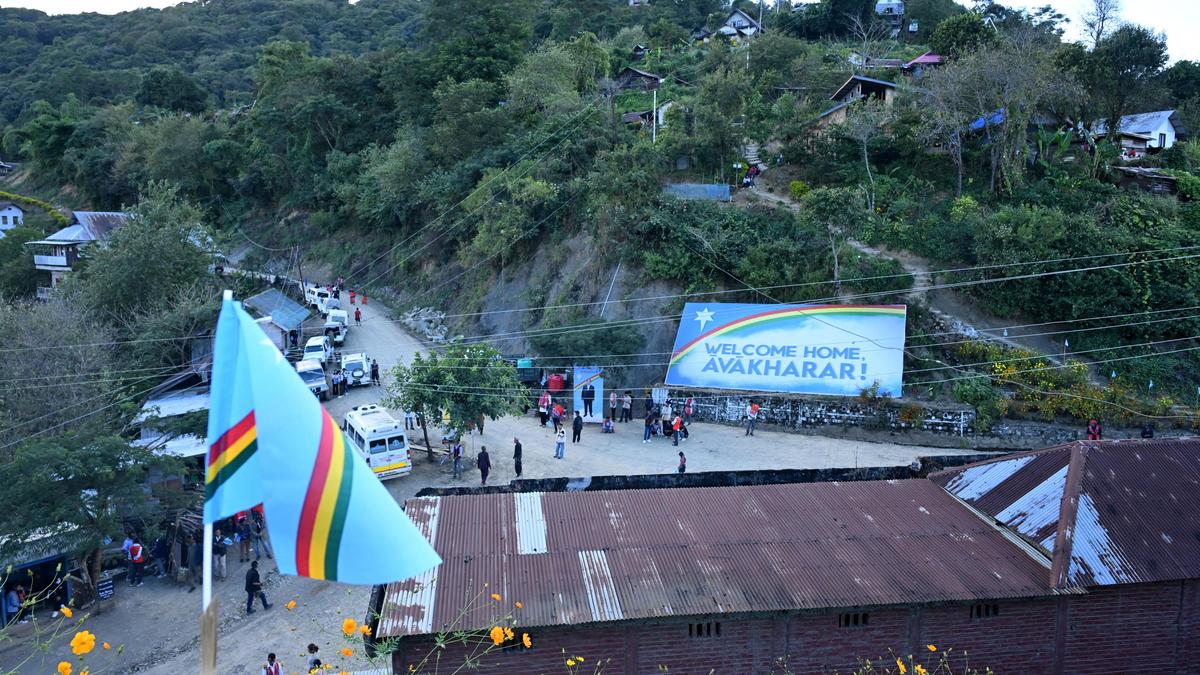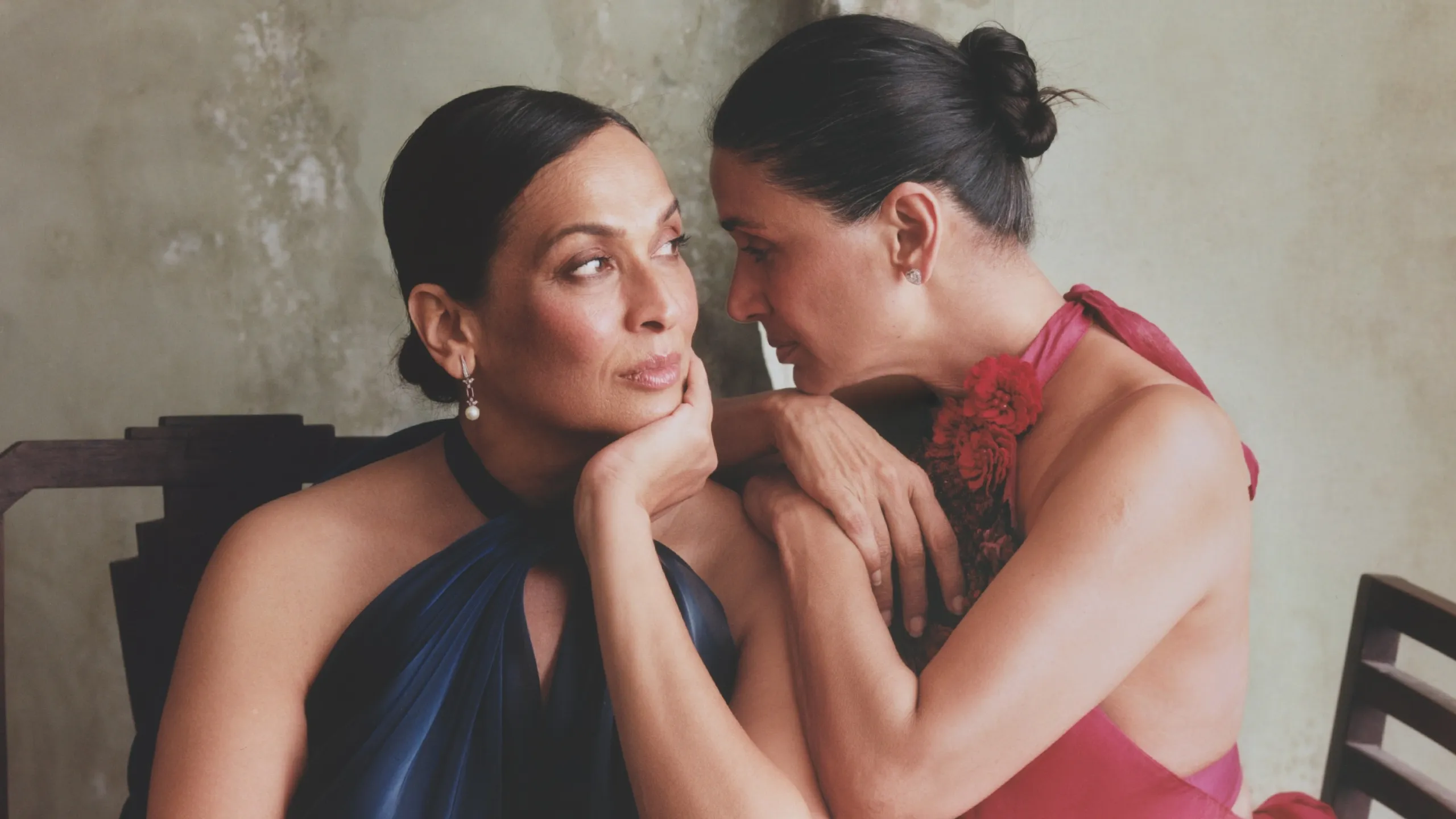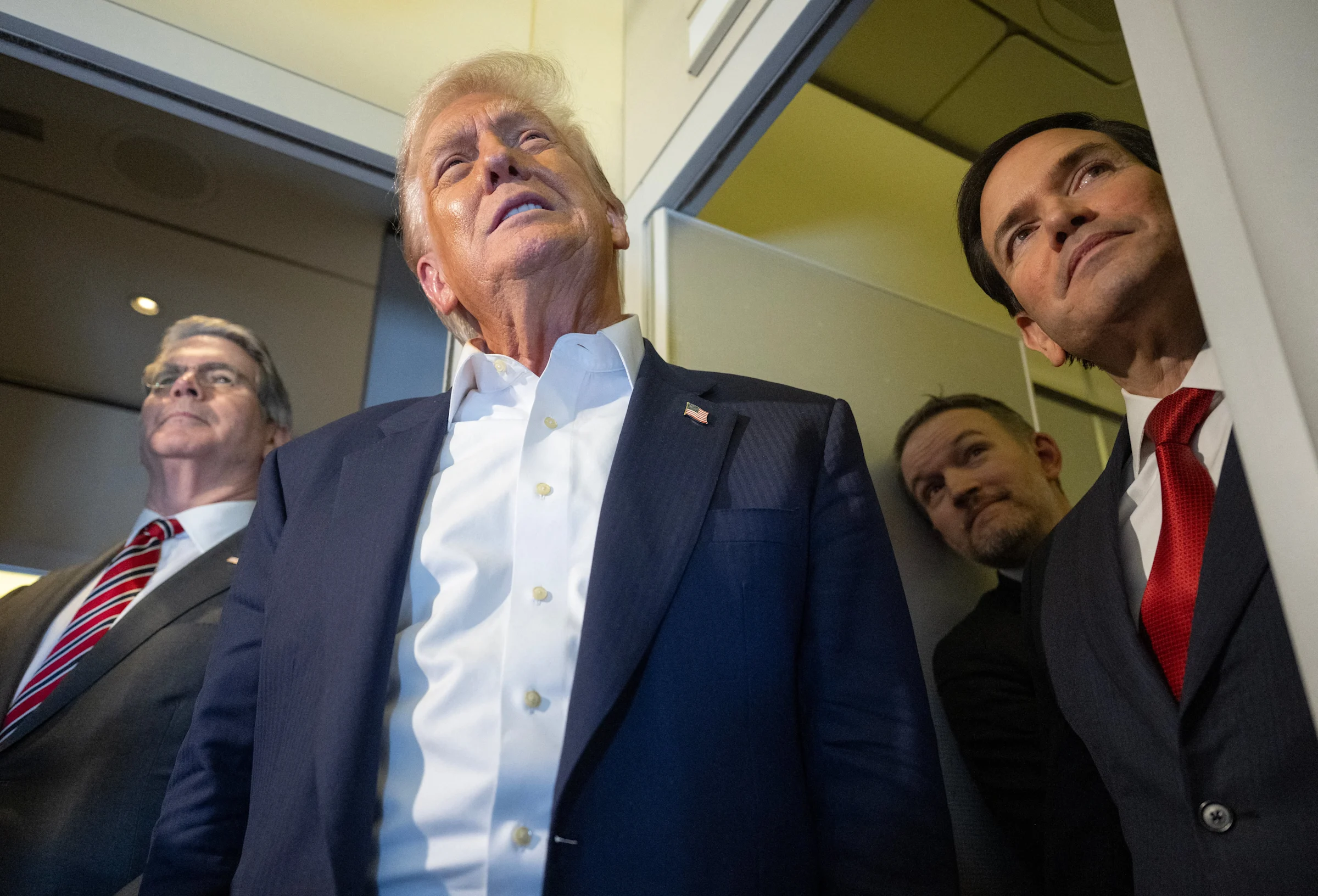Copyright thehindu

A makeshift helipad occupies the space where the Baptist Church stood on a plateaued mound in Somdal, the most discussed village in Manipur’s Ukhrul district bordering Myanmar. The church was dismantled in September for two reasons: at about 100 years, it was too old to be safe for prayer services; and it could yield the most strategic spot for a helicopter carrying a Naga leader — only slightly younger than the church itself — to land on October 22. Thuingaleng Muivah, the 91-year-old general secretary of the extremist National Socialist Council of Nagalim (NSCN) and a devout Christian, probably missed the church when he alighted from the chopper that carried him from adjoining Nagaland’s Dimapur via district headquarters Ukhrul, 25 kilometres from Somdal terrestrially. To most of the village’s 4,500 people around the chopper, however, the landing of their godfather on a spot once commanded by a house of god was surreal. “The church will be rebuilt soon, but the moment he landed in its space was divine,” said 88-year-old Mashithi Moinao, for whom Muivah graduated from an “elder brother” to the avakharar over the six decades he was away from Somdal, his birthplace. Avakharar in the Tangkhul tongue means godfather or a father figure. Somdal and much of the Ukhrul district are dominated by the Tangkhuls, a Naga community whose members form the core of the NSCN, more familiar to the world beyond as the Isak-Muivah faction of the National Socialist Council of Nagaland or NSCN (I-M). The faction is named after Muivah and Isak Chishi Swu, the co-founder of the armed group, who died in June 2016. Out of the intensive care unit of a hospital in Dimapur less than three months ago, Muivah has not been in the best of health. In his speech at the welcome ceremony in Ukhrul hours before reaching Somdal, he thanked god for “preserving me and making it possible for me to return to my birthplace”. The speech was read out by V.S. Atem, the ‘Deputy Prime Minister’ of the so-called government that the NSCN (I-M) represents. Muivah is the Ato Kilonser, or prime minister. The possibility of their avakharar not returning was at the back of the minds of most who gathered in Ukhrul and Somdal to see Muivah in flesh and blood. People across the Tangkhul domain made the most of his homecoming to organise special prayers on October 26, the only Sunday during his eight-day trip. “We prayed for his good health and long life,” said Jerry Muinao, a Somdal-based social worker. Without the church, the special service was organised at the village’s multi-purpose hall for half an hour after Muivah arrived — sprightlier than on the day he arrived, struggling to walk — at 8 a.m. from Gethsemane, a refurbished community hall and his temporary address in Somdal. The multi-purpose hall and his ancestral house are both about 2.5 km from Gethsemane, but in different directions. Almost midway between his house and the place of his temporary stay is his bronze statue, along with that of his wife, under a nativity-like structure. The statues were erected in April, when the residents of Somdal were not sure whether the hurdles before Muivah’s return to his village would be removed. Unifying force? Some claim that Muivah visited Somdal briefly in 1973, almost a decade after he joined the Naga movement, which made a call called to secede from India. Others say he could not make it beyond a jungle near his village because of a strong military presence. All, however, agree that the roads for the rebel to Somdal were strewn with thorns until recently. This primarily had to do with the NSCN (I-M)’s concept of Nagalim, a greater or unified Naga homeland, which the Manipur government and civil society groups in the Meitei-dominated Imphal valley perceived as a threat to the State’s territorial integrity. Although no longer in focus, the Greater Nagalim map included all Naga-inhabited areas of the northeastern region and adjoining Myanmar. This meant an area of more than 57,400 sq. km straddling Arunachal Pradesh, Assam, Manipur, Nagaland, and the Naga Self-Administered Zone in Myanmar’s Sagaing Division. The Manipur government’s fear stemmed from the fact that a ‘unified Naga homeland’ would mean nothing for Muivah and the NSCN (I-M) without Ukhrul and the adjoining Naga-inhabited districts of the State. This fear made the Manipur government, then headed by Okram Ibobi Singh of the Congress party, mobilise forces to thwart Muivah’s last attempt in May 2010 to visit Somdal by road. Muivah’s convoy was stopped near the Mao gate on the Manipur-Nagaland border, about 120 km short of Somdal. Two people were killed when the security forces opened fire to control pro-Muivah protestors. For New Delhi, Muivah continues to be a hurdle for his insistence on two preconditions deemed outside the purview of the Constitution of India — the Yehzabo or Naga constitution and a Naga flag — for the settlement of the Naga peace process that was given a direction when the Centre and the NSCN (I-M) inked the Framework Agreement on August 3, 2015. Although the NSCN (I-M), in November 2024, threatened to “resume the violent armed struggle against India” if the Framework Agreement was not adhered to, the clearance to the homecoming of Muivah in the autumn of his life by the Manipur government under President’s Rule indicated an easing of approach to the vexed issue. His visit to Somdal also pointed to the changing dynamics after the ethnic clashes erupted between the Kuki-Zomi and the Meitei communities on May 3, 2023, claiming more than 250 lives. The Nagas, the second-largest ethnic group after the Meiteis, were neutral in this conflict. Muivah’s acceptance among the non-Nagas was evident from the leaders of influential Meitei groups, such as the Coordinating Committee on Manipur Integrity (COCOMI) and the All-Manipur United Clubs’ Organisation, who attended his welcome ceremony. The COCOMI was formed in 2019 to counter the NSCN (I-M)’s earlier goal of Greater Nagalim. Its spokesperson Athouba described Muivah as a “tall leader” and his visit as a “historic moment”. Organisations such as the radical Meitei Leepun hailed the Centre for its “wise and compassionate decision” to let Muivah return home, albeit briefly. Its chief, Pramot Singh, hailed the NSCN (I-M) leader as “a respected leader of the Naga people” and “an inspirational and visionary figure admired across communities”. There were no representatives from the Kuki-Zomi communities, the third-largest ethnic group in Manipur, at the events to welcome Muivah in Ukhrul. Their organisations, however, welcomed Muivah’s visit, signalling reconciliation given a violent past — more than 1,000 people were killed in the Kuki-Naga clashes in the 1990s — for the sake of a shared future. Manipur’s hills, comprising about 90% of the State’s landmass, are shared between the Naga and the Kuki-Zomi groups. While the Zomi Re-Unification Organisation celebrated Muivah’s return as a “moment of joy”, the Eastern Kuki Chiefs’ Association in the Tangkhul-dominated Kamjong district praised his “tireless efforts” in the Naga political struggle. Critical voices In Manipur, Muivah seemed to have evolved from a separatist Naga icon to a leader more acceptable among the non-Nagas. Some, though, are critical of the changing narrative. A group espousing Kukiland, an administrative region minus the areas inhabited by the Meiteis and Nagas, acknowledged Muivah’s right to visit any place “inside the Manipur Naga territories” but said it was neither excited nor bothered about his visit to his birthplace. Claiming that Manipur’s three communities “live in their own separate lands by now”, it advised the Centre to grant separate administration to each of these communities to ensure peace and prosperity. Ahead of Muivah’s visit, the Zeliangrong United Front, an armed group representing the Zeme, Liangmai, and Rongmei Nagas, sought an apology from him for alleged atrocities inflicted by the NSCN (I-M) on their tribesmen. It insisted there was no reason to glorify an individual who “failed the Nagas on all fronts” and visited his native village “empty-handed” decades after going out on a mission for his people. “...He ordered merciless killings of many prominent leaders in the name of Naga nationalism and sovereignty. He ordered arson in villages in the name of taxation or fighting the Indian Army, and it was all the common Nagas who made the sacrifices,” the Front stated. This pointed to a section of Nagas not being on the same page as Muivah and his organisation vis-à-vis the Naga peace process. Muivah addressed the concerns during his break among his fellow villagers. “The issue we are fighting for is greater and older than most of us who are gathered here...,” he said, adding that the “historic national decision for a sovereign Nagalim” has been defended and consolidated from the battlefield to the negotiating table. “We have not surrendered the free existence and sovereignty of Nagalim, and we shall defend the sovereign national decisions of Nagalim to the last, come what may,” he stated. What mattered more for the young and old across the Tangkhul domain was the presence of their “national hero” amid them. “God has a plan for everything, the peace process included. For now, He has willed our avakharar to be with us,” Naokahao Shitung, 62, the pastor of Ramva Baptist Church in Ukhrul said. “We are too happy to think about what can or cannot be in the future,” Ukhrul’s Shonreingam Layam, 30, said. Octogenarian Elisabeth Tungshsngnao of Langtang, a village near Ukhrul, believed everything Muivah fought for would become a reality, but “probably not while we are alive”. Overcome by emotions Many people in Somdal and elsewhere in the Ukhrul district have met at least once before his October homecoming, but in Nagaland’s Camp Hebron, the NSCN (I-M)’s central headquarters since its members came out of the jungles and elsewhere in the country, after the ceasefire effective from August 1, 1997. Lalotla Shimrang, 80, met him in New Delhi, where his deceased son stayed. “Having him among us in our backyard is a different feeling,” she said. Raripam Rungshung, the secretary of Somdal, underlined the positives of Muivah’s visit. “The government posted a doctor at our Community Health Centre ahead of his visit. We did not have any for years,” he said, hoping that the roads to the village — it needs an SUV to cover a 25 km stretch to the village in less than two hours — would improve along with the infrastructure of Somdal’s schools. Two of these schools, one privately run, are higher secondary, and one is primary. Khanot Ruivah, a former principal of a college in Ukhrul, recalled growing up with Muivah and other friends at Somdal. He met the NSCN (I-M) leader in Dimapur in 2022 and did not expect him to come home, given the complications of the Naga peace process. “He appeared frail at that time, and as we parted ways, I hoped we could meet at least once before we die,” he said. Three of Muivah’s siblings — sister Longrungla and brothers Shangreihan and James — died when he was away marshalling his fighters and negotiating with the government. The only other survivor, the 84-year-old Asui Muivah, is a former village chairman. “I wish we had the family reunion earlier, but it is better late than never,” he said. His brother-turned-avakharar indicated his homecoming may have been a tad too late. “Many people who I knew and who loved me are missing,” he said via Atem, as he surveyed his people from behind a pair of dark glasses. Behind them, he teared up, his aides wiping his cheeks.



